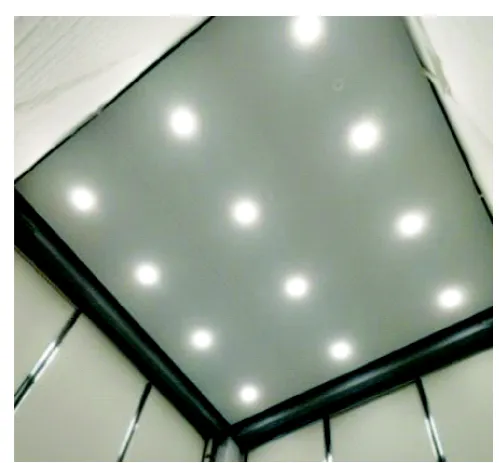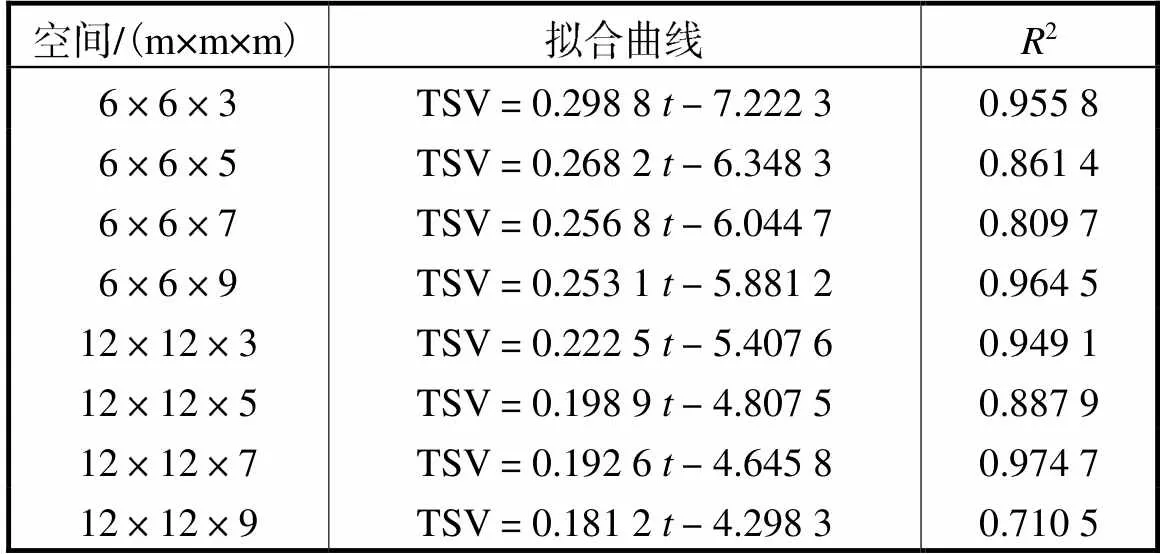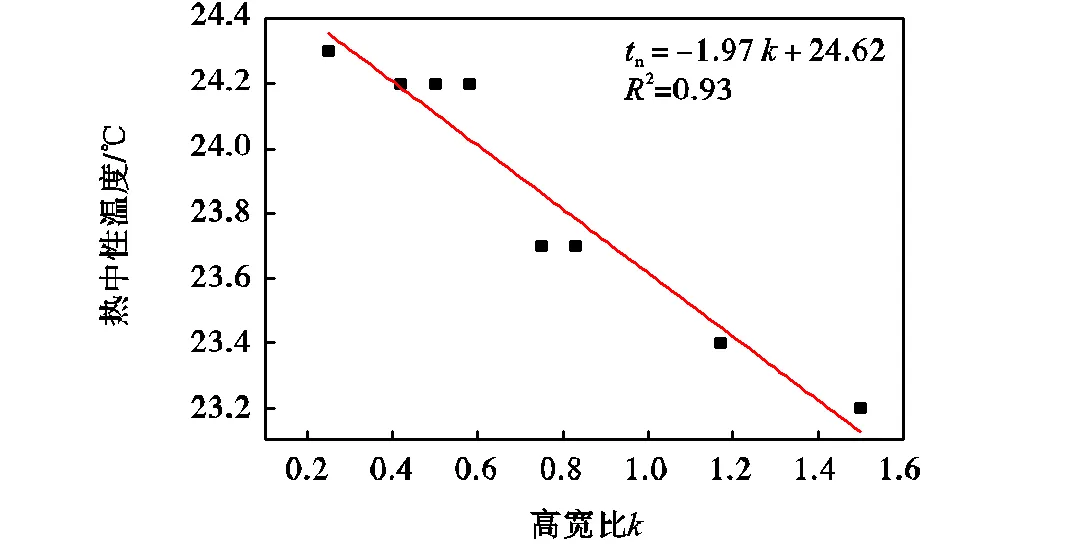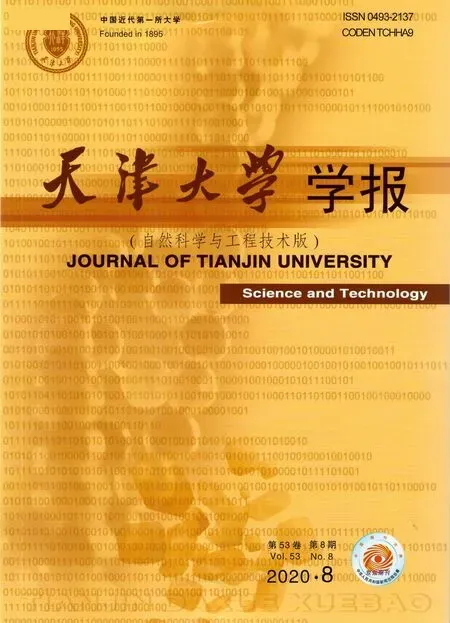地板辐射供冷系统建筑空间尺寸参量对热感觉的影响
刘 刚,钱 叶,刘魁星,聂 婷,黄文龙
地板辐射供冷系统建筑空间尺寸参量对热感觉的影响
刘 刚1, 2,钱 叶1, 2,刘魁星1, 2,聂 婷3,黄文龙4
(1. 天津大学建筑学院,天津 300072;2. 天津大学天津市建筑物理环境与生态技术重点实验室,天津 300072;3. 天津大学国际工程师学院,天津 300072;4. 中国中建设计集团有限公司,北京 100037)
热舒适度是环境舒适度的主要方面,目前,室内环境的热舒适受到越来越多的关注,多变的建筑空间以及复杂的空调系统都会影响室内人员的热感觉,进而影响室内人员的身心健康和工作效率.由于地板辐射空调系统主要依赖辐射换热,故采用地板辐射的建筑中室内人员的热感觉与建筑空间尺寸参量之间的关系尤其值得研究.在天津大学可变建筑空间综合实验平台进行实验,实验时间是2018年9月8日—13日,供冷空调末端是地板辐射,房间底面积有6m×6m和12m×12m,房间高度有3m、5m、7m和9m,共8种实验工况.采用主观调查问卷与热环境参数测量相结合的方法,主观调查问卷包括热感觉投票和热满意率百分比,实验过程中操作温度的波动范围是22.8~26.7℃.实验结果表明,夏季采用地板辐射供冷时,建筑空间尺寸参量对地板辐射供冷下被试者的热感觉有明显影响:对比两种底面积的空间中被试者在各高度下的热感觉,发现趋于狭窄的建筑中被试者感觉更热;对比8种建筑空间中热感觉随操作温度变化的斜率,发现越是狭窄、低矮的空间,被试者对热环境的变化越敏感;被试者的热中性温度随高宽比增大而减小,即趋于扁平的建筑中被试者的热中性温度越高.这对建筑设计和空调节能都具有一定指导意义.
地板辐射供冷系统;热感觉;高宽比;热中性温度
在居住建筑和公共建筑中,热舒适十分重要,对人员的健康和工作效率均有影响[1-2].多变的建筑空间和复杂的空调系统是影响室内人员热感觉的两个重要方面,且二者有一定的交互影响[3],故研究特定空调末端下不同空间的热舒适具有较大价值.
常用的空调末端有辐射和对流两种.有学者对顶板辐射[4]、风机盘管[5]、踢脚线加热[6]等系统进行研究,目前的研究表明辐射系统下房间温度波动较小且空调系统更节能,因此辐射系统被广泛应用在各种类型的建筑中[7].Rhee等[8-9]从热舒适性、传热模型、供热及制冷能力等方面对辐射系统进行了全面回顾.其中,影响热舒适的最大问题是由于辐射面的空间位置不同造成的辐射不对称性[10-11],常见的有顶板、地板和侧壁辐射.早在1985年,Fanger等[12]实验发现冷壁、暖顶的辐射不对称对被试者的热舒适影响更大,这是空间与辐射效果之间关系的最早研究之一.Tiberiu等[13]采用计算流体动力学(computational fluid dynamics,CFD)结合实验的方法评价了顶板冷辐射下的热舒适.地板辐射下的实验结果表明,被试者的暴露时间[14]、性别及姿势[15]都会影响其热感觉.Conceicao等[16]实验发现,地板辐射冷却的热舒适度优于顶板辐射冷却,与侧壁辐射相结合时,两者都会达到更好的热舒适.
有些学者为了改善辐射系统空间中存在的热不对称等问题,将辐射系统和通风系统相结合展开研究.常见的有以下几种系统:辐射结合置换通风的系统下,头部和踝关节的垂直温差适中,不会增加脚踝处的通风风险,且可以改善结露现象[17-18];辐射结合地板送风的系统可以明显改善热舒适,同时也可改善结露现象[19-20];顶板辐射结合通风系统也可以使工作区达到更好的热舒适[21-22].辐射结合对流的空调末端在舒适度方面具有显著优势.
近些年来,辐射系统在高大空间中的优势巨大,因此人们更加关注辐射与空间的关系.高大空间的建筑特点是横跨大、玻璃幕墙多即保温性较差.与其他常见于高大空间的系统如射流系统和置换通风系统相比,辐射系统能避免风机能耗过大、冷负荷处理能力较小的问题.清华大学的Zhao等[23-25]针对采用地板辐射系统的航站楼内热物理场和热舒适度进行了一系列研究.热物理场方面,他们提出了一种简单的预测稳态太阳辐射下地板辐射冷却性能的方法,并进一步研究了太阳辐射对重型和轻型地板辐射制冷能力的影响.热舒适度方面,他们在咸阳国际机场进行现场实测,发现冬夏季均有以下结论:采用地板辐射的3号航站楼内的热舒适度明显比采用射流通风的2号航站楼好.
最近,有研究人员不但关注了空调末端对热感觉的影响,同时关注了整个建筑特性与空调末端对热感觉的交互影响.Xu等[3]在3个典型空间中研究了建筑空间对环境综合感觉的影响,得到被试者的热中性温度大概值.实验过程中采用地板辐射加风机盘管对室内温度进行控制,并没有区分不同的空调末端.Cen等[26]在供冷季研究了地板辐射和风机盘管两种空调末端下,被试者热感觉受空间高度的影响.实验表明在较高空间下地板辐射系统的热舒适优于风机盘管系统.可见,建筑空间对热感觉的影响是值得研究的.
目前针对不同建筑空间尺寸参量下热感觉的研究,或是没有区分空调末端,或是实验工况较少.故笔者研究了地板辐射制冷工况下,8种建筑空间尺寸参量下被试者热感觉的差异,实验得到了空间对热感觉的影响规律及热中性温度随空间高宽比的变化规律.这可以为建筑空间和空调系统的设计提供一定参考.
1 实 验
1.1 实验工况
该实验在天津大学变空间实验平台进行,实验平台外景见图1.实验在2018年夏季地板辐射供冷工况下完成,房间底面积有6m×6m和12m×12m,高度有3m、5m、7m和9m,共8种实验工况.

图1 外景图


图2 顶板升降控制器

图3 顶板及筒灯
实验空间的空调系统有地板辐射和风机盘管,实验中运行的是地板辐射供冷工况,温度由供回水阀门和流量计共同调节,12m×12m空间的地板辐射的阀门共2个,6m×6m空间的地板辐射阀门共1个.地板辐射末端控制阀见图4.
实验在2018年9月8日—13日进行了8种建筑空间尺寸参量下的热感觉实验,实验工况见表1.

图4 地板辐射的阀门
表1 实验工况

Tab.1 Experimental conditions
1.2 被试者与调查问卷
实验招募了15名天津大学学生为被试者,性别比例大约为1∶1.年龄在22~24岁,平均年龄23岁.被试者着统一服装(短袖、薄长裤、薄短袜、运动鞋),服装热阻0.495clo.
被试者在实验过程中保持静坐;在实验前12h保证睡眠充足、情绪稳定,禁止饮用酒精、咖啡等刺激性饮料;实验前1.5h不能吃东西;实验前3h不要进行剧烈运动.
热舒适调查问卷包括以下内容:被试者的身高、体重、年龄等基本信息,七度热感觉评价和被试者对热环境的满意度.
1.3 热环境参数的测量
在被试者填写调查问卷的同时,实验人员进行室内空气温度、相对湿度、风速、黑球温度的测量和记录.室内热环境测量仪器见图5.

图5 实验仪器
室内环境参数的测量高度在距地面约0.6m处.每个工况下,在实验区域均匀地布置3个测点.室内空气温度的测量仪器为美国ONSET温湿度记录仪(HOBO),HOBO每隔5min测量并记录一次温度数据且可实时显示当前温度数据.风速测量使用TSI model 9545热敏风速仪,实验过程中尽量避免对风速仪附近空气流动的干扰.黑球温度测量使用KIMO TM 200黑球温度计.实验中测量室内环境使用的实验仪器见表2.
表2 热环境测量的仪器及参数

Tab.2 Instrumentsfor measuring the thermal environ-ment and their parameters
1.4 实验方案
由于地板辐射供冷系统需要一定的响应时间,故每次实验前3h打开地板辐射系统.由于太阳辐射对地板辐射系统的性能影响较大[27],实验过程中使用内遮阳并打开室内照明.
由于该实验空间的温度控制有大约±0.5℃的波动,为保证每种建筑空间尺寸参量下在22~27℃至少有4个温度工况,实验过程中充分利用上午、下午、晚上的室外温度变化.在9月8日上午10:08—11:46、9月10日下午14:50—17:38、9月11日晚上19:45—20:32、9月13日下午13:37—15:37进行了41个工况的实验,共填写615份问卷.
当室内温度达到要求的实验工况时,安排被试者进入实验空间先静坐6min,以适应室内热环境,然后填写调查问卷.改变吊顶高度时要求被试者离开实验空间,实验过程见图6.

图6 实验过程照片
2 实验结果
2.1 热环境参数
该实验的室内热环境参数记录见表3.
表3 室内热环境参数记录表
操作温度的波动范围是22.8~26.7℃.其中,操作温度计算式为

式中:为操作温度;g为黑球温度;a为空气温度;为风速;r为辐射换热系数;c为对流换热系数.
2.2 问卷结果
2.2.1 热感觉
2种底面积时,热感觉投票(thermal sensation vote,TSV)随操作温度的变化见表4.
由表4可知,6m×6m和12m×12m的空间中,操作温度波动范围分别是22.8~26.1℃和23.2~26.7℃.12m×12m的空间中,低温区域的工况较少,这是由于实验中很难把12m×12m空间的温度控制在23℃以下.
2.2.2 热满意率
底面积6m×6m、12m×12m的工况下,被试者的不满意百分比(percentage dissatisfied,PD)分别见图7(a)和图7(b).
表4 热感觉问卷的结果

Tab.4 Results of the TSV questionnaires

图7 2种底面积下PD随操作温度的变化
由图7可见,该实验中被试者的不满意百分比PD的范围是0~40%,ISO 7730规定允许有10%的人感觉不满意,结果表明该实验的室内热环境并没有完全满足ISO 7730的要求.
对比PD和TSV,在较低的操作温度范围内TSV更接近零,即较低的操作温度更接近热中性温度;实验过程中两个极高的不满意百分比为40%,均出现在室内操作温度较高的区域,即较高的操作温度下被试者满意率更低.这表明,被试者的不满意百分比PD结果与平均热感觉投票TSV结果是一致的.
3 数据分析
3.1 高度、底面积对TSV的影响
底面积6m×6m时,4种高度下的平均热感觉投票TSV随操作温度的变化见图8(a),底面积 12m×12m时见图8(b).
由图8可知,相同的操作温度下,6m×6m空间下,整体趋势是建筑高度9m时,TSV最高;高度3m时,TSV最低.12m×12m空间下各高度下的TSV没有明显差别.与6m×6m相比,12m×12m的空间下,4种高度的TSV曲线更接近.

图8 2种底面积下TSV随操作温度的变化
建筑空间的高度为3m、5m、7m和9m时,2种底面积时的TSV随操作温度的变化见图9.
由图9可知,相同的操作温度下,6m×6m的空间热感觉均高于12m×12m的空间,即狭窄空间中感觉更热;且呈现的趋势是高度越高,2种底面积下热感觉TSV曲线的差距越大.

图9 4种高度下TSV随操作温度的变化
3.2 不同建筑空间下的TSV拟合曲线
地板辐射供冷工况下,8种建筑空间尺寸参量下的TSV随操作温度的变化规律的拟合曲线见表5.
由表5可知,8种建筑空间尺寸参量下,TSV与操作温度的线性相关系数2都较高,只有12m×12m×9m空间下2较低,这可能是被试者人数较少造成的.
底面积6m×6m和12m×12m两种空间下均有以下规律:随着高度增加,TSV-曲线的斜率越来越小,换言之,越是低矮的建筑空间,被试者对热环境的变化越敏感.

表5 地板辐射供冷系统8种建筑空间尺寸参量下的TSV-t曲线
4种高度下均有以下规律:底面积越大,TSV-曲线的斜率越小,换言之,越是狭窄的建筑空间,被试者对热环境的变化越敏感.
3.3 高宽比对热中性温度的影响
8种建筑空间尺寸参量下的热中性温度n随高宽比呈线性下降,见图10.两者关系满足函数关系n=-1.97+24.62,线性相关系数2=0.93.
由图10可知,地板辐射供冷工况下,热中性温度随高宽比的增大而减小.高宽比的变化范围是 3∶12~9∶6即0.25~1.50,热中性温度的变化范围是23.2~24.3℃.

图10 热中性温度随高宽比的变化
夏季地板辐射供冷工况,在建筑空间的高宽比较小即建筑较扁平时,被试者的热中性温度较高,可以一定程度降低建筑的空调能耗.
4 结论及展望
笔者在地板辐射供冷空间中测量热环境参数,同时收集热感觉问卷.实验研究了8种建筑空间尺寸参量对热感觉的影响.通过比较8种建筑空间尺寸参量下,操作温度对平均热感觉投票TSV的影响,及不同高宽比空间中被试者的热中性温度,得到在地板辐射供冷的建筑空间有以下主要结论:
(1) 在趋于狭窄的建筑中,被试者会感觉更热;
(2) 越是狭窄、低矮的空间,被试者对热环境的变化越敏感;
(3) 趋于扁平的建筑中,被试者的热中性温度 越高.
热舒适研究中,被试者的心理因素可能对热感觉有影响,需进一步对心理通道进行研究;另外,建筑声环境和光环境对被试者热舒适的影响也需要进一步研究;由于该实验是用15名天津大学学生作为被试者进行的,故该研究结论仅适用于身体健康的中国大学生.在接下来的研究中,需要比较更多的建筑空间、空调末端形式,并增加被试者的人数使研究结果更加精确.
[1] Monika F,Pawel W. Literature survey on how different factors influence human comfort in indoor environments[J]. Building and Environment,2011,46(4):922-937.
[2] Fang L,Wyon D P,Clausen G,et al. Impact of indoor air temperature and humidity in an office on perceived air quality,SBS symptoms and performance[J]. Indoor Air,2010,14(Suppl 7):74-81.
[3] Xu Hong,Huang Qiong,Zhang Qi. A study and application of the degree of satisfaction with indoor environmental quality involving a building space facto[J]. Building and Environment,2018,143:227-239.
[4] 田 喆,王 硕,朱 能,等. 冷却顶板系统的供热性能及热舒适效果[J]. 天津大学学报,2010,43(12):1109-1114.
Tian Zhe,Wang Shuo,Zhu Neng,et al. Performance and thermal comfort of chilled ceiling system in heating mode[J]. Journal of Tianjin University,2010,43(12):1109-1114(in Chinese).
[5] Antonio A M,José M C L,Francisco F H. A comparison of heating terminal units:Fan-coil versus radiant floor,and the combination of both[J]. Energy and Buildings,2017,138:621-629.
[6] Adnan P,Sture H. Low-temperature baseboard heaters with integrated air supply:An analytical and numerical investigation[J]. Building and Environment,2011,46:176-186.
[7] Olesen B. Radiant floor cooling systems[J]. ASHRAE Journal,2008,50:16-22.
[8] Rhee K N,Kim K W. A 50 year review of basic and applied research in radiant heating and cooling systems for the built environment[J]. Building and Environ-ment,2015,91:166-190.
[9] Rhee K N,Olesen B W,Kim K W. Ten questions about radiant heating and cooling systems[J]. Building and Environment,2017,112:367-381.
[10] Wang Zhaojun,He Yanan. Human skin temperature and thermal responses in asymmetrical cold radiation environments[J]. Building and Environment,2013,67:217-223.
[11] Kuskana K. Asymmetric Radiant Fields and Human Thermal Comfort[D]. Leicester:Institute of Energy and Sustainable Development,de Montfort University,2005.
[12] Fanger P O,Ipsen B M,Langkilde G,et al. Comfort limits for asymmetric thermal radiation[J]. Energy and Buildings,1985,8(3):225-236.
[13] Tiberiu C,Joseph V,Frederic K. Evaluation of thermal comfort using combined CFD and experimentation study in a test room equipped with a cooling ceiling[J]. Building and Environment,2009,44(8):1740-1750.
[14] Zhou Xiang,Liu Yunliang. Thermal comfort under radiant asymmetries of floor cooling system in 2 h and 8 h exposure durations[J]. Energy and Buildings,2019,188/189:98-110.
[15] Chrenko F A. The effects of the temperatures of the floor surface and of the air on thermal sensations and the skin temperature of the feet[J]. British Journal of Industrial Medicine,1957,14(1):13-21.
[16] Conceicao E Z E,Lucio M M J R. Evaluation of thermal comfort conditions in a classroom equipped with radiant cooling systems and subjected to uniform convective environment[J]. Applied Mathematical Modelling,2011,35(3):1292-1305.
[17] Causone F,Baldin F,Olesen B W,et al. Floor heating and cooling combined with displacement ventilation:Possibilities and limitations[J]. Energy and Building,2010,42(12):2338-2352.
[18] Schiavon S,Bauman F S,Tully B,et al. Chilled ceiling and displacement ventilation system:Laboratory study with high cooling load[J]. Science and Technology for the Built Environment,2015,21(7):944-956.
[19] Francisco F H,José M C L,Alberto F G,et al. A new terminal unit combining a radiant floor with an under-floor air system:Experimentation and numerical model[J]. Energy and Buildings,2016,133:70-78.
[20] Raftery P,Lee K H,Webster T,et al. Performance analysis of an integrated UFAD and radiant hydronic slab system[J]. Applied Energy,2012,90(1):250-257.
[21] Corgnati S P. Heat Flows and Air Distribution in Rooms Cooled by Radiant Panels[D]. Torino:Polytechnic of Torino,2002.
[22] Chiang Weihwa,Wang Chiaying,Huang Jiansheng. Evaluation of cooling ceiling and mechanical ventilation systems on thermal comfort using CFD study in an office for subtropical region[J]. Building and Environment,2012,48:113-127.
[23] Zhao Kang,Liu Xiaohua,Jiang Yi. Application of radiant floor cooling in a large open space building with high-intensity solar radiation[J]. Energy and Buildings,2013,66:246-257.
[24] Zhao Kang,Liu Xiaohua,Jiang Yi. Dynamic performance of water-based radiant floors during start-up and high-intensity solar radiation[J]. Solar Energy,2014,101:232-244.
[25] Zhao Kang,Liu Xiaohua,Jiang Yi. On-site measured performance of a radiant floor cooling/heating system in Xi’an Xianyang International Airport[J]. Solar Energy,2014,108:274-286.
[26] Cen Chao,Jia Yihong,Liu Kuixing,et al. Experimental comparison of thermal comfort during cooling with a fan coil system and radiant floor system at varying space heights[J]. Building and Environment,2018,141:71-79.
[27] Tang Haida,Zhang Tao,Liu Xiaohua. Novel method for the design of radiant floor cooling systems through homogenizing spatial solar radiation distribution[J]. Solar Energy,2018,170:885-895.
Influence of Building Space Dimension Parameters on the Thermal Sensation of Floor Radiation Cooling System
Liu Gang1, 2,Qian Ye1, 2,Liu Kuixing1, 2,Nie Ting3,Huang Wenlong4
(1. School of Architecture,Tianjin University,Tianjin 300072,China;2. Tianjin Key Laboratory of Architectural Physics and Environmental Technology,Tianjin University,Tianjin 300072,China;3. Tianjin International Engineering Institute,Tianjin University,Tianjin 300072,China;4. China Construction Engineering Design Group Corporation Limited,Beijing 100037,China)
Thermal comfort is the main aspect of environmental comfort. At present, the thermal comfort of indoor environments is receiving increasing attention. The changeable building space and complex air-conditioning system affect the thermal sensation of occupants, thereby affecting their physical and mental health and work efficiency. Because the floor radiation air-conditioning system mainly depends on radiation heat transfer, the relationship between the thermal sensation of indoor workers and the building space dimension parameters in buildings with floor radiation is particularly worth studying. The experiment was carried out on the Comprehensive Experiment Platform of Variable Building Space of Tianjin University from September 8, 2018 to September 13, 2018. The cooling air-conditioning terminal is floor radiation. The floor areas of the rooms are 6 m×6 m and 12 m×12 m, and the heights of the rooms are 3 m, 5 m, 7 m, and 9 m.There are eight kinds of experimental conditions.The subjective questionnaire is combined with the measurement of the thermal environment parameters. The subjective questionnaire includes the thermal sensation vote and percentage of thermal satisfaction. The fluctuation range of the operating temperature during the experiment is 22.8—26.7℃. The experimental results show that when floor radiation cooling is used in summer, the building space dimension parameters have a significant effect on the thermal sensation of the subjects. The comparison results of the thermal sensation of the subjects at different heights in the two kinds of floor space show that the subjects felt hotter in the buildings that tended to be narrower. Furthermore, the comparison results of the slope of the thermal sensation variation with the operating temperature in the eight building spaces show that the narrower and lower the space, the more sensitive the subjects are to the change in the thermal environment. The thermoneutral temperature of the subjects decreases with the increase of the aspect ratio. In other words, the flatter the building, the higher the thermoneutral temperature. This has certain guiding significance for building design and energy saving of air-conditioning systems.
floor radiation cooling system;thermal sensation;aspect ratio;thermoneutral temperature
the National Key Research and Development Program(No.2016YFC0700200),the Natural Science Foundation of Tianjin,China(No.2017FQ-0013).
TU83
A
0493-2137(2020)08-0777-08
10.11784/tdxbz201907061
2019-07-23;
2019-11-04.
刘 刚(1977— ),男,博士,教授,lglgmike@163.com.Email:m_bigm@tju.edu.cn
刘魁星,liukuixing1@sina.com.
国家重点研发计划资助项目(2016YFC0700200);天津市自然科学基金资助项目(2017FQ-0013).
(责任编辑:田 军)

